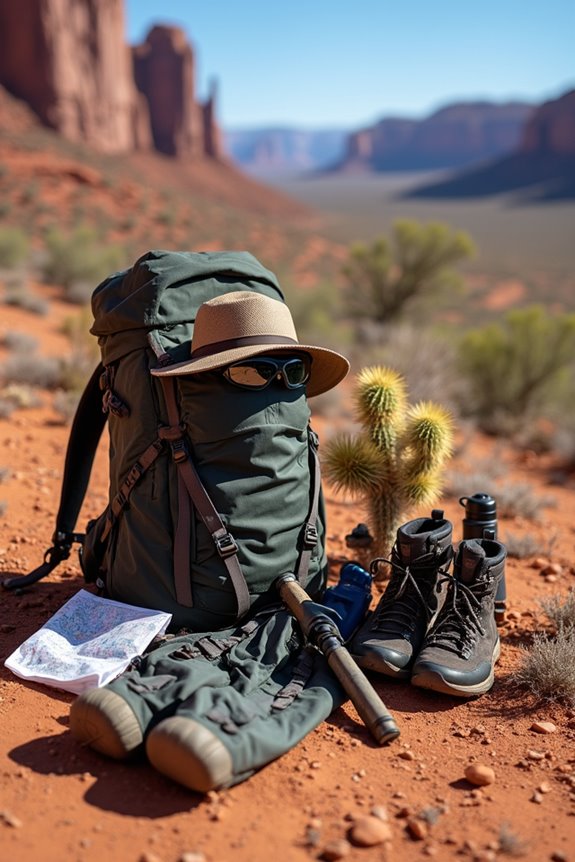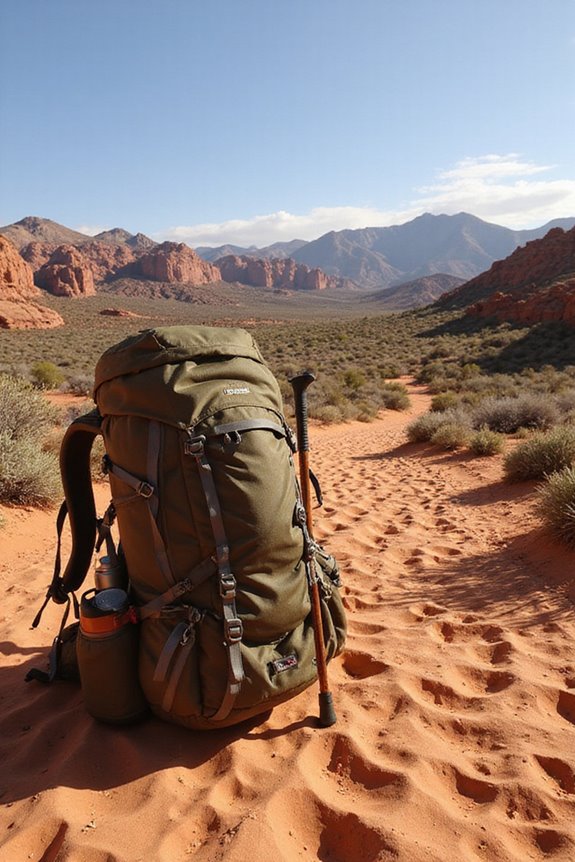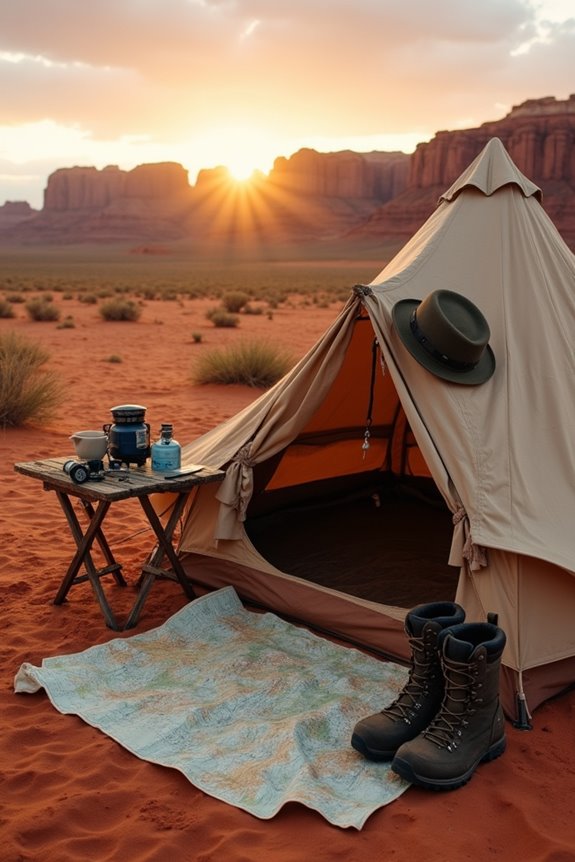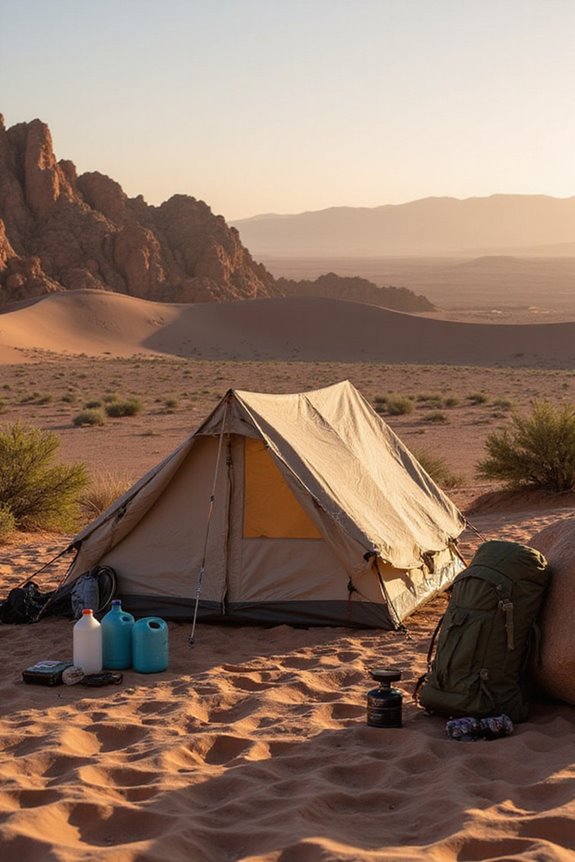When we’re packing for a desert hike, hydration is our first priority—let’s aim for at least 2 liters! We need lightweight, breathable clothing to fend off that scorching sun, and don’t forget wide-brimmed hats and UV-protective sunglasses! Sturdy, ventilated footwear keeps us comfy and blister-free, while snacks like trail mix will keep our energy up. A map, compass, and emergency gear are essentials, too. Stick around, and we’ll cover more tips to make our adventure a breeze!
Key Takeaways
- Pack at least 2 liters of water per person and hydrate regularly to prevent dehydration in the desert heat.
- Wear lightweight, breathable clothing and a wide-brimmed hat to protect against sun exposure.
- Use moisture-wicking socks and breathable footwear to manage foot comfort and prevent blisters in sandy terrain.
- Bring navigation tools like a topographic map and a GPS device for safe navigation in remote areas.
- Carry lightweight, calorie-dense snacks to maintain energy levels while hiking in the harsh desert environment.
Hydration and Water Management
When it comes to hitting the desert trails, we can’t underestimate the importance of staying hydrated! We’re talkin’ about serious hydration strategies here. Aim for 7 to 10 ounces of water every 10 to 20 minutes to keep our bodies functioning like well-oiled machines. For shorter hikes, let’s pack at least 2 liters per person; if we’re going the distance, bump it up to a gallon! Don’t forget electrolyte balance—plain water won’t cut it. Mixing in electrolyte drinks can save us from cramping up in the heat. Oh, and hydrate before we even get on the trail—16 to 20 ounces a few hours ahead? Absolutely! Consider an insulated stainless steel water bottle that keeps drinks cold for up to 24 hours, perfect for scorching desert temperatures. So, grab those durable water bottles, and let’s quench our thirst for adventure!
Clothing and Sun Protection
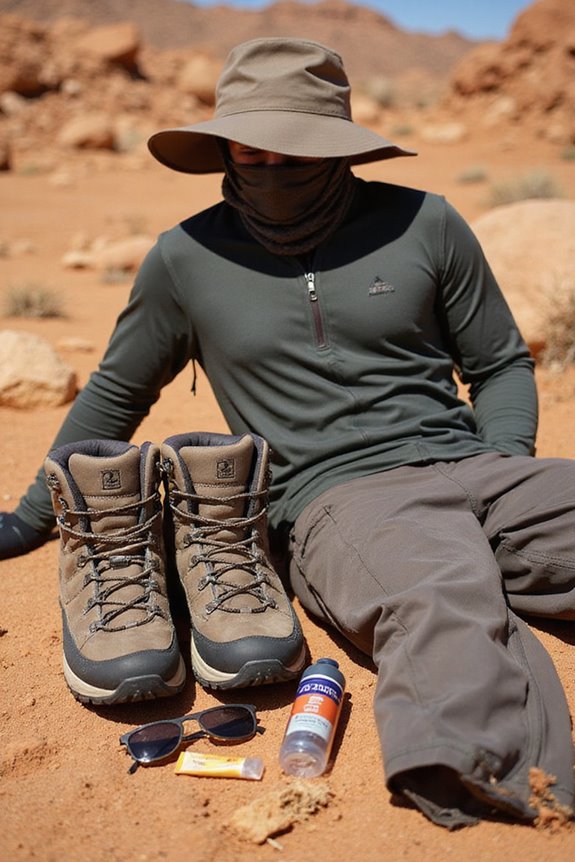
Gear up, friends! When we’re headed into the desert, we’ve gotta think about clothing materials and sun protection like it’s our secret weapon against the blazing sun. We’ll want lightweight, breathable fabrics—think polyester or merino wool—to keep us cool and dry. Say no to cotton; we don’t want to feel like we’re wading through a swamp!
Choosing light-colored, loose-fitting long-sleeve shirts and pants not only reflects heat but also shields us from pesky bugs and thorns. Plus, let’s crown ourselves with wide-brimmed hats and UV-protective sunglasses; they’ll give our faces that ‘I’m adventure-ready’ look while blocking harmful rays. Look for hats with UPF 50+ ratings for maximum protection against the desert’s intense UV exposure. Remember, we’re summer warriors, battling the sun with style and a dash of flair!
Footwear and Foot Protection
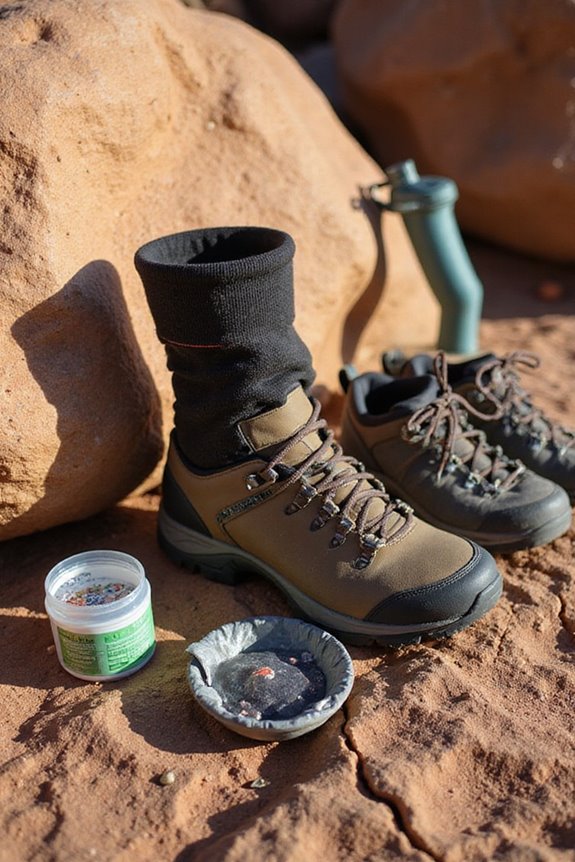
Finding the right footwear for desert hiking is essential if we want to conquer those sun-baked trails in comfort and style. Whether we’re opting for open-style sandals for ventilation or sturdy over-ankle boots for solid support, our choice can make all the difference. Remember, breathable footwear types are key for staying cool!
We should prioritize foot care too—looser fits help as our feet swell in the heat. Using moisture-wicking socks can keep blisters at bay, which is a major win during long hikes. If sand and debris become pesky foes, consider gaiters to keep them out. Look for shoes with excellent traction capabilities to prevent slips on loose desert terrain. With the right gear locked in, we can embrace the freedom of the desert, feeling every step as an adventure waiting to unfold!
Navigation and Emergency Gear
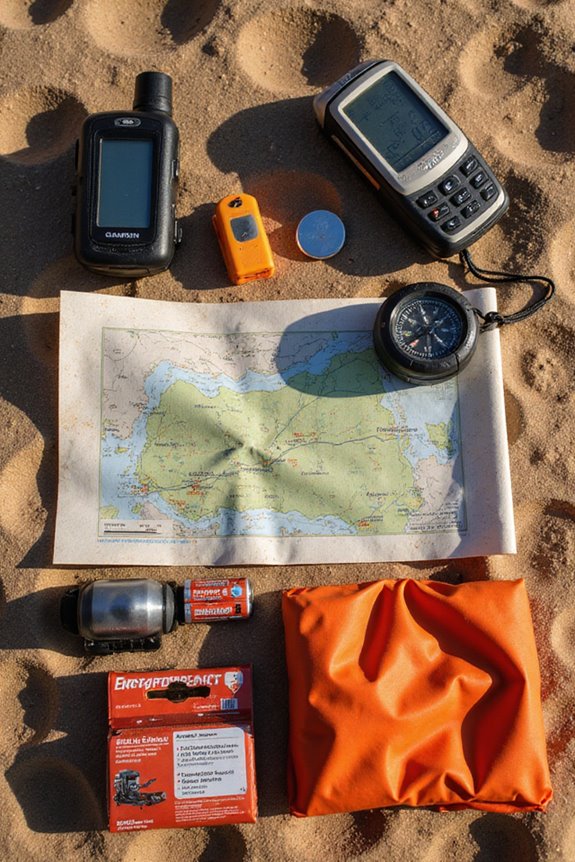
Maneuvering the vast and often desolate beauty of the desert can be a thrilling challenge, but without the right navigational tools and emergency gear, we might find ourselves lost in more ways than one! We can’t rely solely on apps; let’s pack a trusty topographic map, compass, and maybe even a GPS as backup. An altimeter watch is a game changer for tracking elevation.
For emergency signaling, a whistle can be our best friend, while a signal mirror can work magic in catching attention. A personal locator beacon can provide crucial satellite connectivity for emergency situations in remote desert locations. Don’t forget that headlamp with extra batteries for those unexpected nighttime adventures! With these navigation tools and gear in tow, we’re not just prepared—we’re ready to explore the desert’s secrets with confidence and freedom!
Backpack and Packing Considerations
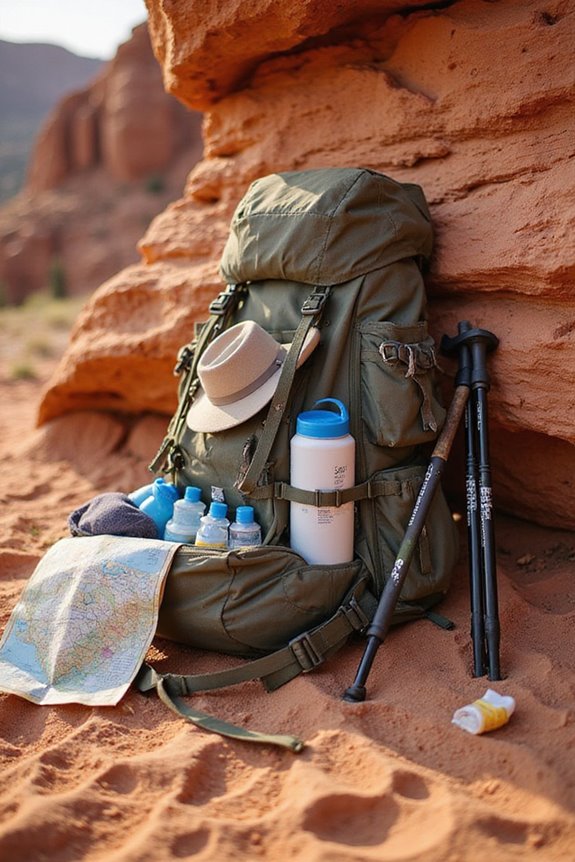
When we’re gearing up for a desert hike, choosing the right backpack is essential to guarantee we stay hydrated and comfortable throughout our adventure! We love hydration backpacks with integrated water bladders—these beauties let us sip easily without breaking our stride. For longer treks, we need larger packs that can carry at least 100 oz of water and some extra gear. Think about the weight distribution; heavier items like water should sit close to our backs for balance.
Having multiple compartments is a total game changer. They keep essential items, like sunscreen and snacks, within easy reach. Plus, with ventilated panels to stay cool and compression straps to stabilize our load, we’ll tackle those sandy trails like pros! Remember to pack lightweight survival gear for unexpected weather changes and emergency situations that might arise during your desert expedition.
Additional Desert Hiking Essentials
After packing our trusty backpack with hydration and gear, we’re just about ready to hit those stunning desert trails, but let’s not forget the other essential items that make our hiking experience safe and enjoyable! First up, a thorough first aid kit is a must. We can’t let a blister or a pesky insect sting put a damper on our adventure. For wildlife safety, let’s include a small snakebite kit—better safe than sorry!
And don’t overlook safety gear like a whistle and a reflective emergency blanket; they’re lifesavers in tricky situations. Finally, some trusty hiking poles can help us keep our balance while tackling those rugged terrains. With these essentials packed, we’ll be ready to embrace freedom on those mesmerizing trails!
Nutrition and Food Supplies
Packing the right nutrition for our desert hikes isn’t just smart; it’s essential for keeping our energy up and our spirits high! We should think snack selection early—grab lightweight, calorie-dense goodies like nuts, trail mix, and energy bars. Meal planning is key, too. Let’s start the day with a calorie-rich breakfast to fuel our adventure and pack high-carb, high-fat snacks to munch every 30 minutes on the trail. This way, we can maintain our energy and avoid the dreaded hangry state! And don’t forget an end-of-day meal loaded with carbs and proteins for recovery. With the right nutrition, we’ll conquer those trails while feeling light and free! Let’s get ready for a flavorful journey!
First Aid and Health Considerations
While we’re out there conquering those stunning desert trails, it’s essential to stay prepared for any health hiccups along the way! We can’t overlook first aid techniques, especially in the unforgiving desert. A well-stocked first aid kit is our best ally; think assorted bandages, sterile dressings, and multi-use tools for those unexpected scrapes. Let’s keep our health awareness high by recognizing dehydration signs and packing oral glucose for a quick energy boost! Carry antihistamines for those quirky desert allergies, and don’t forget sunscreen—our skin deserves some love! Plus, we should pack biodegradable soap to keep those hands clean. With these essentials, we can tackle any challenge that comes our way while soaking in the wild freedom of our desert adventure!
Weather Preparedness and Gear
When it comes to desert hiking, preparation is a game changer, especially when the weather is as wild as the terrain! We’ve got to embrace the desert climate’s unpredictable weather patterns, so let’s gear up right. Lightweight, breathable clothing, like long pants or moisture-wicking shirts, keeps us cool and protected from the sun’s fierce rays. And don’t forget a wide-brimmed hat and UV sunglasses—our eyes will thank us later! Hydration is key, too. We should carry a hefty hydration pack and sip water regularly to fend off dehydration. Plus, having a map and compass handy guarantees we don’t wander off like lost tumbleweeds. Let’s gear up, hit those trails, and revel in the freedom of desert exploration together!
Frequently Asked Questions
How Do I Identify Safe Water Sources in the Desert?
When identifying safe water sources in the desert, we can look for signs from desert wildlife. Using water filtration methods on gathered moisture guarantees our hydration needs are met while staying connected to nature’s offerings.
What Should I Do in Case of Snake Encounters?
In nature’s dance, we celebrate freedom, but snake safety whispers caution. When encountering a snake, let’s freeze and calmly retreat. With knowledge of prevention, we’ll boldly embrace our adventures amidst the wilderness’s unseen challenges.
How Can I Manage Fatigue During a Long Hike?
To manage fatigue during long hikes, we should focus on hydration strategies and energy snacks. By staying hydrated and munching on nutritious snacks, we’ll maintain our energy and enjoy the freedom of exploring the great outdoors.
Are There Specific Plants to Avoid in the Desert?
When hiking, we should definitely avoid dangerous cactus species and poisonous plants. By staying aware of our surroundings and recognizing these hazards, we can embrace the freedom of the desert while keeping ourselves safe.
What Are the Signs of Heat Exhaustion and Heat Stroke?
In our journey through the sun’s relentless fire, we must heed the signs of heat exhaustion symptoms—fatigue, dizziness, and thirst. By embracing heat stroke prevention, we guarantee our spirits remain unbridled and adventurous, always seeking cool refuge.

